[Topic] UAV in Digital Construction

1. Background
From a report by McKinsey, construction-related spending accounts for 13% of the world’s GDP, however, the annual productivity growth of construction sector has only increased 1% over the past 20 years [1]. Another report also clearly shows us the low productivity and the low digitalization of construction industry (Fig.01, Fig.02) [2]. The reason of it is that current construction process is highly fragmented: inadequate and non-flexible design process, poor project management, high dependence on human labor as well as unpredictable onsite situations. Around $2.01 trillion of additional value added could be created through higher productivity, meeting half the world’s infrastructure need [1]. The McKinsey Global Institute estimates that the world will need to spend $57 trillion on infrastructure by 2030 to keep up with global GDP growth [2]. This is a huge incentive for construction industry to find a more productive process.
2. Data flow and digital construction
The productivity of a future design-to-construction process depends on its digital construction organization, and the key point is an efficient data flow. Data need to be updated accurately and timely during the whole process.
Why is the data flow so important? Before design, data of the site need to be collected. During design process, if the situation of the site has been changed, the site data should be updated. When the site data is wrong, the whole design would need to be re-planned. During construction, the as-built building needs to be compared to the as-designed, building process needs to be tracked and updated, issues should be detected and reported, solutions should be integrated into the original design as well. Since construction is always a big project with the participation of different parts, reliable data flow is essential for the collaboration. These tasks usually take workers lots of energy and time.
With the development of technologies, such as BIM (Building Information Modeling) technology, GIS (Geographic Information System), LiDAR (Light detection and ranging), high quality image processing, AR (Augmented Reality) / VR (Virtual Reality) and construction robotics, a more efficient digital design-to-construction process becomes increasingly tangible.
3. UAV in digital construction
UAV (Unmanned Aerial Vehicle) has been playing a more and more important role in commercial and civil government applications and is creating increasingly larger market opportunities. It brings huge changes in many industries, also in construction. A report by Goldman Sachs (Fig.03) indicates that the largest expected market for commercial drones is in construction [3]. UAV can play an important role in the data flow of the design and construction process by integrating other technologies into itself. Because of its high mobility, it can easily collect large amount of data in short time, which can significantly increase the efficiency.
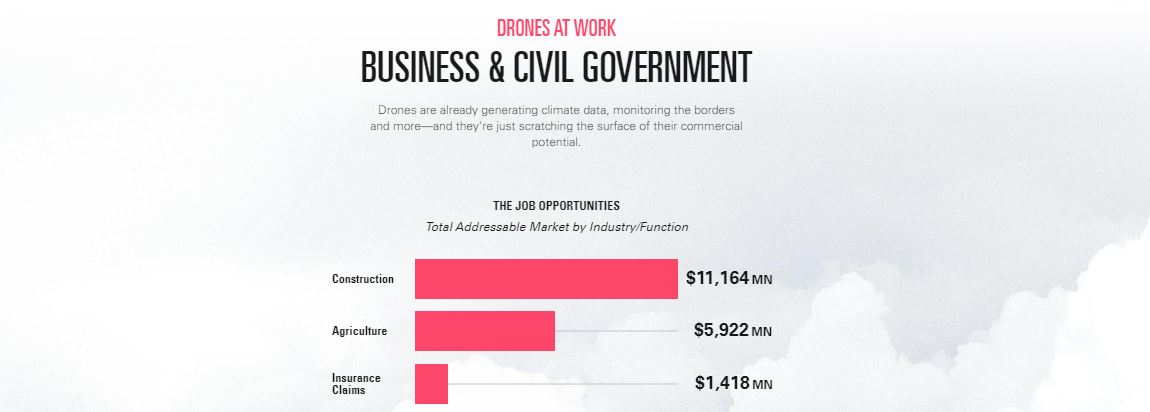
4. Application Scenarios
So what can UAV do in digital construction process? Well, it can almost take part in every part! Unlike traditional construction machines, UAV can reach any point in space and fly around existing objects. It is a huge advantage.
4.1. Pre-Planning
UAV has already been used in many projects for surveying the site and re-building an accurate digital model. The digital model can help the design group get a better idea of the site. For design and construction, the output model should be easily integrated into related BIM software for further use.


4.2. Visualizing Design
With camera-equipped drones and AR technology, architects can show design to their customers in a more intuitive way. In the near future, by wearing a pair of glass, the customers can directly see how the design looks like on the site.

4.3. Remote monitoring and reports
Construction progress reports are often prepared monthly or weekly to record site progress. These reports include the surveyors taking multiple photographs of various parts of the site. Construction site inspections can be dangerous and complicated sometimes. A regular drone flight can be a speedy way to record and visualize project progress, which also reduces risks.
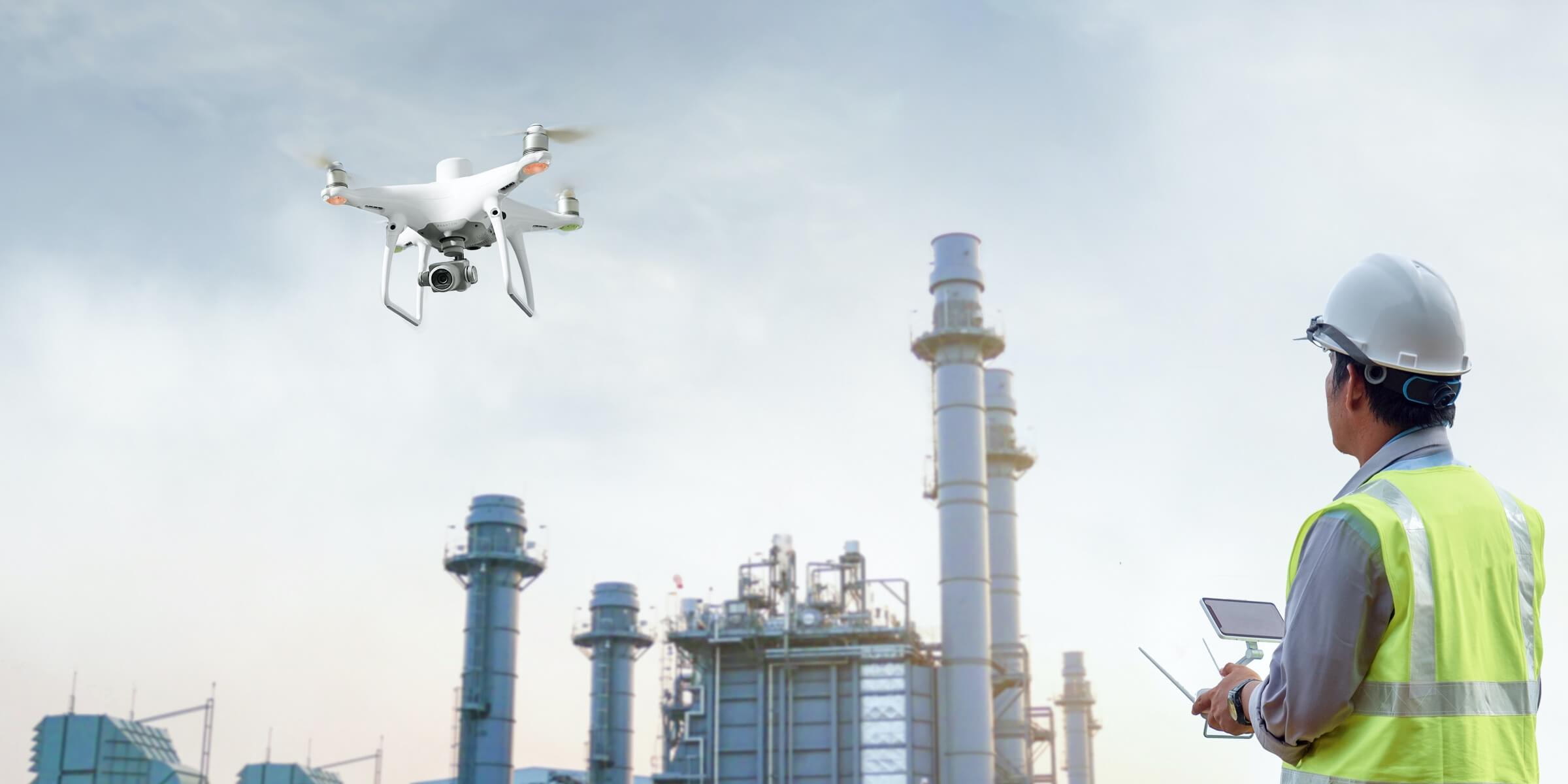
4.4. Identifying safety concerns
When performing the inspections, if a drone with an intelligent image recognition system observes that physical data doesn’t match design data, or if it finds unusual structural deflection, it can report the problems immediately to center control system as well as project manager.
4.5. Collaboration
Future construction process will be more organized and automated. Workers on site can be not only human, but also construction robots. Construction sites are ever evolving and the movements on-site do not always stick to the plan. With its high mobility and visual-inspections ability, drone can be a good construction supervisor can provide a real-time update of what is going. The project manager or center control system will then send proper commands to corresponding workers.
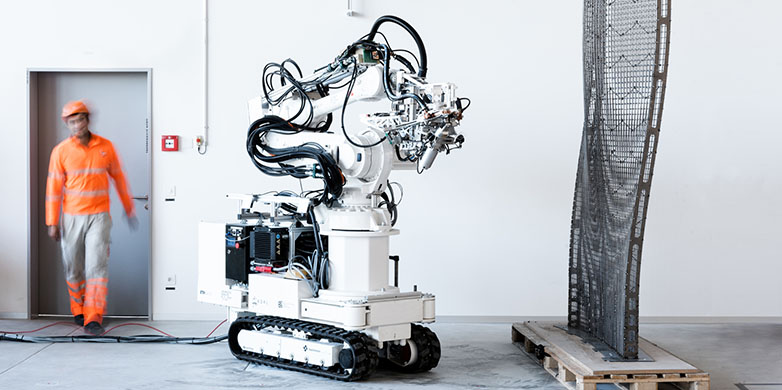
4.6. Transportation and assembly
Beside inspecting, researchers are also imaging drones performing like smart builders and can carry and place materials at job sites. A lot of related projects are under development. For example, a team from ETH has developed a group of UAVs to built a rope bridge (Fig.09). Project ICD/ITKE Research Pavilion 2016-17 has employed UAV and KUKA Robot to build a fiber structure collaboratively (Fig.10). Over 1500 lightweight modules are placed by a multitude of UAVs based on predefined algorithm in another project from ETH (Fig.11). A master thesis of ITECH program has explored the possibility to employ UAVs as builder to reconstruct a reconfigurable and intelligent architecture for public spaces (Fig.12).



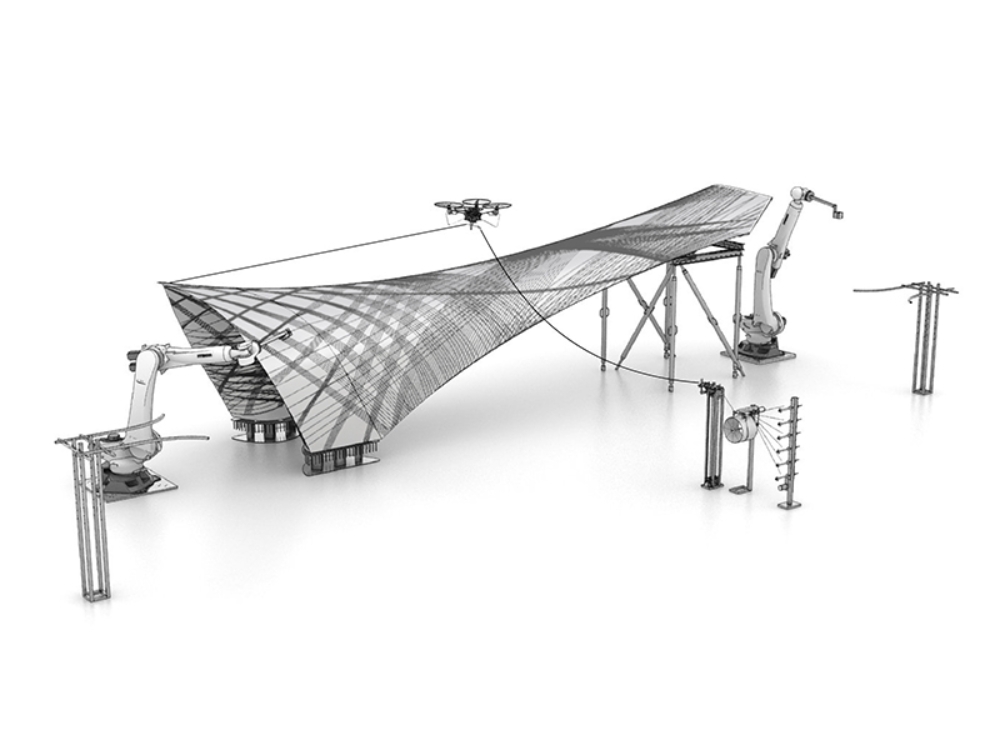
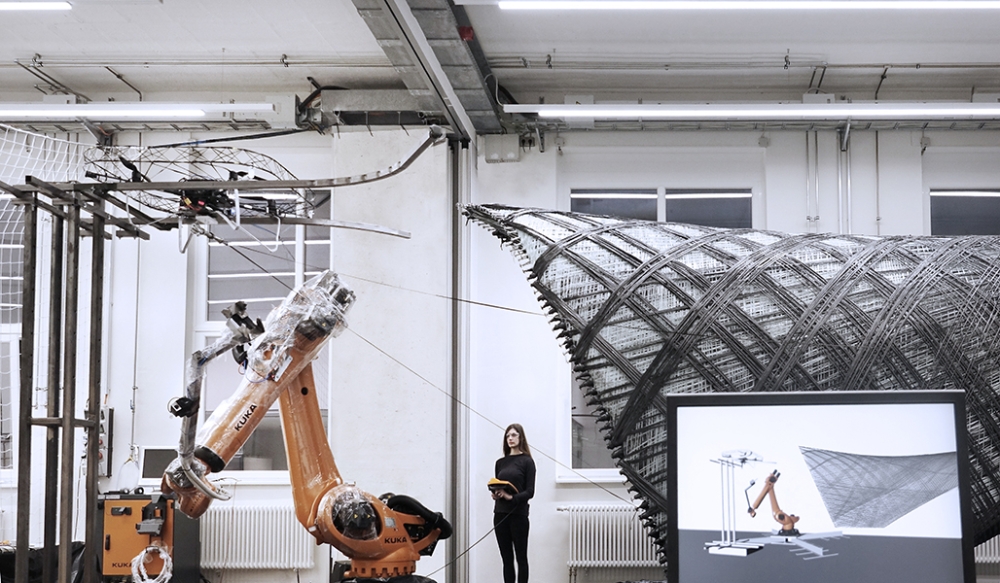

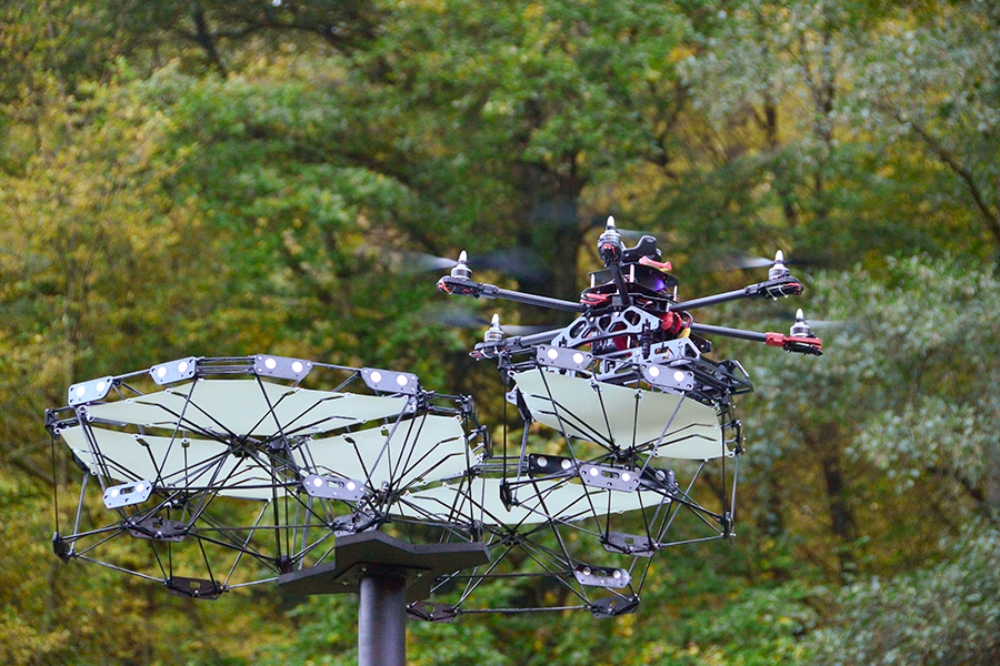
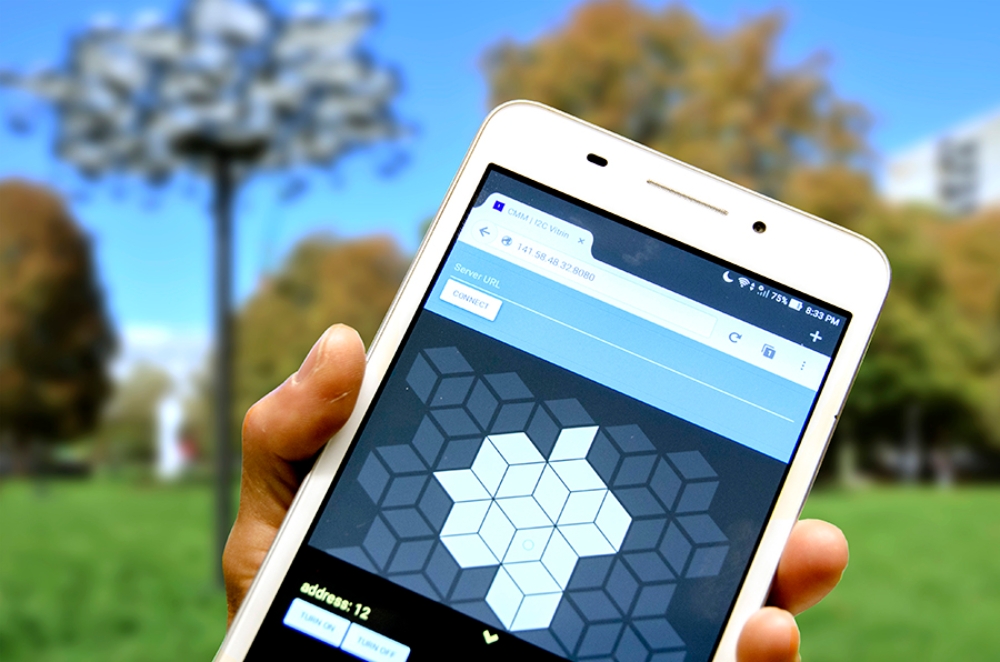

5. Challenges
UAV has lots of possibilities in the area of digital construction and can definitely play an important role. However, there are also a few challenges currently.
- Weather conditions. There are certain weather conditions that prevent the UAV from working correctly, which might influence the construction progress.
- Detect-and-avoid abilities. Safely flying a drone around construction sites can be tricky with all the obstacles, buildings and people around the construction area, since there are many uncertainties on the site.
- Limited payload and accuracy for assembly tasks.
- Battery performance for long-time tasks.
- BIM integration. To build a smoother digital design-to-construction workflow, the updated data collected from the UAV need to be integrated into BIM software (such as revit) with less effort.
- Collaboration with other robots. The collaboration possibilities between drones and other construction robots are not fully developed yet.
6. Outlook
The construction industry with huge market possibilities is now trying to get more digitalized, the need for greater efficiency comes in all aspects of this transformation. Real-time information and collaborative platform are the key challenges. In future digital construction process, UAVs will not only be an important and irreplaceable player as a data collector and a process inspector, but also be able to work as a builder who can collaborate with other construction robots on site.
7. References
[1] Reinventing construction through a productivity revolution. [Online] Available: https://www.mckinsey.com/industries/capital-projects-and-infrastructure/our-insights/reinventing-construction-through-a-productivity-revolution. Accessed on: Jul. 2020
[2] Imagine the construction’s digital future. [Online] Available: https://www.mckinsey.com/industries/capital-projects-and-infrastructure/our-insights/imagining-constructions-digital-future Accessed on: Jul. 2020
[3]Goldman Sachs Drone Report. [Online] Available: https://www.goldmansachs.com/insights/technology-driving-innovation/drones/ Accessed on: Jul. 2020
[4]DJI Phantom 4 RTK. [Online] Available: https://enterprise.dji.com/cn/news/detail/phantom4-rtk Accessed on: Jul. 2020
[5]Autodesk BIM 360, Site Scan. [Online] Available: https://integrations.bim360.autodesk.com/3DR/Site+Scan/ Accessed on: Jul. 2020
[6]Drone in construction management, DJI. [Online] Available: https://enterprise.dji.com/cn/oil-and-gas/exploration-and-construction-management Accessed on: Jul. 2020
[7]Aerial Construction, ETH Zurich. [Online] Available: https://idsc.ethz.ch/research-dandrea/research-projects/aerial-construction.html Accessed on: Jul. 2020
[8]ICD/ITKE Research Pavilion 2016-17, University of Stuttgart. [Online] Available: https://www.icd.uni-stuttgart.de/projects/icditke-research-pavilion-2016-17/ Accessed on: Jul. 2020
[9]Flight Assembled Architecture, ETH Zurich. [Online] Available: https://gramaziokohler.arch.ethz.ch/web/e/projekte/209.html Accessed on: Jul. 2020
[10]Cyber Physical Macro Material, ITECH M.Sc. Thesis 2017, University of Stuttgart. [Online] Available: https://www.icd.uni-stuttgart.de/teaching/master-theses/cyber-physical-macro-material-as-a-uav-reconfigurable-architectural-system/ Accessed on: Jul. 2020

